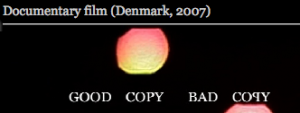Here is my second column on SFFC for the Seattle Univeristy Law Prolific Reporter:

If you have tried to set up a movie viewing at [Seattle University Law] for a student organization lately you have probably run into the new copyright compliance policy. Before showing a move at the school outside of a structured class you must gain copyright clearance from the copyright owner. The reason the school is doing this is fear of lawsuit, copyright comes with stiff statutory damages, an unauthorized public viewing of a copyrighted could come with penalties up to $150,000. What has been the effect of this policy; most student organizations have stopped showing films due the the transactional cost of having to clear rights. The time need to clear rights can take hour or days, time that is better spent studying for evidence or legal writing.
Is this policy good for student orgs? No, it makes it tougher for orgs to share information or rally students around a cause. Is this good for film makers? No less students see their work and less people will hear their message. Is this good for the rights holder? No, rights holders are not likely make any money off student org that have an annual budget of $200. Simply put the blanket policy is not good for anyone.
I am not one to complain, unless I am willing to change things. The school should consider implementing a fair use policy related to student orgs use of films. Fair use is the part of the copyright act that protects users from infringement claims. Another way to look at fair use is the codification of the first amendment in the copyright act. The use of a film for educational, noncommercial purposes in a way that promotes a public interest cause is very likely considered fair use. Here is a first draft of a suggested policy:
Student orgs may show films as long as they meet the following criteria:
1. The film showing must be noncommercial in nature: no charging admission, taking donations or exchanging money in any way.
2. The film showing must be for an educational purposes that is directly related the the student orgs mission.
3. The film showing must not take place if the film are currently being shown in a commercial venue within 20 miles of Seattle.
4. The film showing should be accompanied by other educational activities, such as a discussion of the films subject mater and how it relates the the student orgs mission.
If you have interest in learning more about how copyright creates problems Students for Free Culture’s showing of:
GOOD COPY BAD COPY - a documentary about the current state of copyright and culture.
The documentary features interviews with many people with various perspectives on copyright, including copyright lawyers, producers, artists and even the MPAA. The point of the documentary is the thesis that “creativity itself is on the line” and that a balance needs to be struck, or that there is a conflict, between protecting the right of those who own intellectual property and the rights of future generations to create. The showing is Tuesday October 28th at 7:30pm in Room: C7.
PS: I did not have clear rights on Good Copy Bad Copy the film was released under a Creative Commons Attribution-NonCommercial license which encourages public use. To read more about fair use and creative commons follow my blog at freedomforip.org/blog/ and join Student for Free Culture. If we do not use our rights they are lost.
Attribution: The description of the documentary was remixed from Wikipedia and the image was taken from the intro screen of the film.

